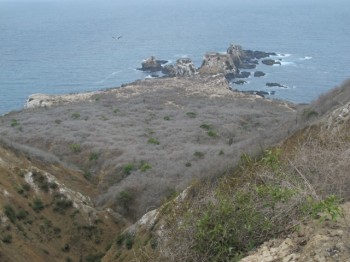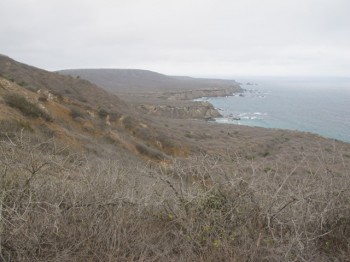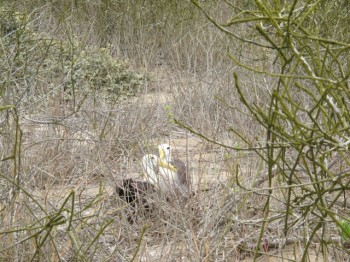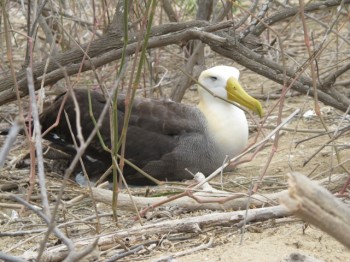
Isla de la Plata is 41 kilometres offshore from the fishing village of Puerto López on the mainland of Ecuador. The photo above shows Punta Machete, facing west. This is the main breeding site for the 12 ACAP-listed Waved Albatross Phoebastria irrorata pairs known to frequent the island. The arid 1200-ha island forms part of the 46 000-ha Machalilla National Park, which includes a 14 430-ha Ramsar Wetland of International Importance (Zona Marina Parque Nacional Machalilla, Site No. 503, designated in 1990).
The west coast of Isla La Plata.

The coastline is home to several seabird species, including Nazca Sula granti and Blue footed. S. nebouxii Boobies. Red-footed Boobies S. sula, Magnificent Frigatebirds Fregata magnificens and Red-billed Tropicbirds Phaethon aethereus also breed on the island. The NGO Island Conservation successfully removed feral domestic goats Capra aegagrus hircus from the island in 2008 and feral cats Felis catus in 2009 (click here).

A pair of Critically Endangered Waved Albatrosses on Isla La Plata. Most nests are found within vegetation, primarily among bushes.

Photographs by Sebastian Cruz
A Waved Albatross closely broods its chick on La Plata. The chick can just be seen.
Click here to read of an ACAP outing to Isla La Plata in August 2011 at the time of the Sixth Meeting of its Advisory Commitee.
Selected References:
ACAP 2008. Plan of Action for the Waved Albatross (Phoebastria irrorata). AC4 Doc 50 rev.4. 30 pp.
Anderson, D. J.; Cruz, F. 1998. Biology and management of the Waved Albatross at the Galápagos Islands. In: Robertson, G. & Gales, R. (Eds). Albatross Biology and Conservation. Chipping Norton: Surrey Beatty & Sons. pp. 105-109.
Anderson, D.J., Huyvaert, K.P., Apanius, V., Townsend, H., Gillikin C.L., Hill, L.D., Juola, F., Porter, E.T., Wood, D.R., Lougheed, C. & Vargas, H. 2002. Population size and trends of the Waved Albatross Phoebastria irrorata. Marine Ornithology 30: 63-69.
Awkerman, J.A., Huyvaert, K.P., Mangel, J., Alfaro Shigueto, J. & Anderson, D.J. 2006. Incidental and intentional catch threatens waved albatross population. Biological Conservation 133: 483-489.
Sebastian Cruz, Max Planck Institute for Ornithology, Radolfzell, Germany and John Cooper, ACAP Information Officer, 15 April 2013

 English
English  Français
Français  Español
Español